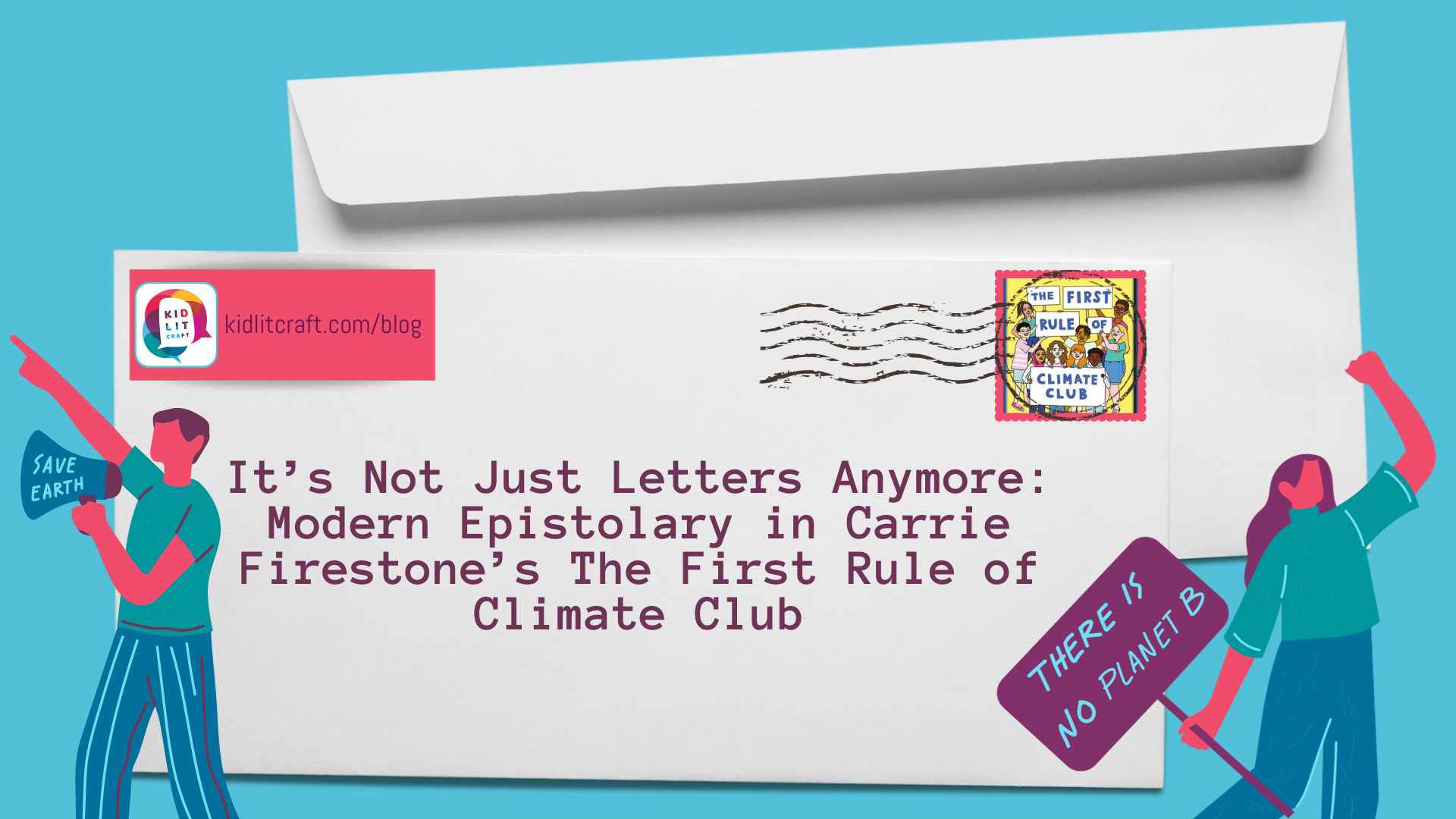craft review by Cathy Petter
Carrie Firestone’s middle grade novel The First Rule of Climate Club is a large-cast gem that takes on complacent adults, love for our planet, friendship and middle school. In this follow-up to Dress Coded, Fisher Middle School’s new eighth graders get the opportunity to participate in a science class pilot program devoted to climate change. Firestone tells their story through protagonist Mary Kate’s eyes, but Firestone’s use of a slew of different communications gives the author room for other points of view as well. Let’s take a deep dive into how she does it.
Meet kids where they communicate
Firestone combines a lot of media to tell her story, in addition to the first-person-POV scenes narrated by Mary Kate.
- Text chains
- Letters, to parents, to town officials, to the editor (published in the local paper), and even in a journal to Mary Kate’s baby niece
- Application essays to the pilot science class
- English class assignments
- Podcast scripts
- Lists, both “to do” and others
- Flyers posted at school and around town
Solving the problem of a large cast of characters
There are a lot of advantages to building a large cast in your novel, but one of the biggest challenges is that readers can struggle to remember who’s who. Firestone employs a wonderful strategy to help her readers: the character’s application essay to the climate change class. These essays give her an opportunity to share the character’s backstory, the skills they might bring with them into the class (and to the struggles portrayed in the story), their hopes and dreams. Even better, Firestone shares the essays through her story, typically placing the relevant essay as an introduction to a chapter where that character plays a key role. Once we’ve read their story, they become unforgettable.
All the things a letter can do
Not long ago, my teenager asked me where the stamp goes on an envelope. I hung my head in shame. Letters were such a huge part of my childhood and young adult years. They were the way I stayed connected with my grandparents, my California pen pal, my high school friends while in college and my college friends during school vacations. But life is very, very different for kids growing up today.
Firestone’s use of letters meets readers where they are and introduces them to the possibility of letter writing. Here are some ways she includes letters:
- School notifications: Familiar even to Gen Z, Firestone sets up the story with a simple letter to parents notifying them that their student has been selected for the pilot program.
- Political activism: Once the class creates Climate Club, and discovers that adults in their community don’t always play fair, Firestone has them write letters to their mayor, letters to the editor of the town paper and others, demonstrating the ways that kids can get involved in their community.
- Sharing hopes and dreams: When Mary Kate’s older sister Sarah gives her a locked diary as a godmother gift, Firestone has Mary Kate announce that she’s going to write down everything the baby will ever need to know. Her journal entries are in the form of letters to the baby. Later, in a dark flip, Lucy, Mary Kate’s best friend, suffering a debilitating mystery illness, writes her last will and testament. Firestone’s use of opposites helps the reader recognize the depths of Lucy’s fear and despair at her unknown illness.
Genius addition
As a writer, I love first-person point of view and close third-person point of view for the way I can build a connection with my reader. But I’m always aware of the downside as well: everything is shown through my character’s eyes. Carrie Firestone blew that downside out of the water in this novel by introducing Miss Lane’s English class assignment. Miss Lane instructs the class to write a private letter to themselves, that Miss Lane will collect, but not read. Mary Kate and other class members write the assignment. Firestone places these letters throughout the novel as well, giving another way for readers to learn more about the other kids and understand their points of view.
The beauty of a quick info dump
We’ve all been there. There are things your reader needs to know, but who wants to waste paragraphs or even pages boring them to death? Firestone created brief one- or two-paragraph chapters with snappy headlines, written almost like the answer to a school short essay prompt to bring readers up to speed. “The Hartford Kids” explains that the school includes kids from two different communities. “How to Make a Podcast Go Viral” is a pithy, one-sentence description instead of a boring scene.
Now it’s YOUR turn!
- Make a list of all of the communications you could call on to tell your story. If you’re struggling with your own work, pick a book you love and make a list for that story.
- Divide your communications by purpose: plot development, character development, information.
- Now think about your list in terms of intimacy. How can you use a form of communication to show POV? To build relationships? Which are the most effective forms, given what you want to show?
Find the author on social media:
Check out these posts on writing middle grade novels:
Cathy Petter’s debut picture book, Dear Moxie, Dear Rex, will release in the spring of 2025 from Reycraft Books. She holds an MFA in Writing for Children and Young Adults from Vermont College of Fine Arts, and is a member of SCBWI. She lives in New York City where she writes stories for kids of all ages and schemes to find cheap theater tickets. Find her on Instagram @cath.petter.


COMMENTs:
0